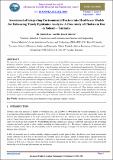| dc.description.abstract | The objective of this study is to assess the perspectives of userson the feasibility of using integrated environmental factors-based healthcare model to enchance timely cholera epidemics analysis in Tanzania.The study used a mixed-design approach of quantitative and qualitative methods with focus group discussion and interviewer-administered questionnaires. Participants or users included;medicalandepidemiological experts, environmental experts, Information and CommunicationTechnology (ICT) experts, and cholera patients from Ilala, Ubungo, Kigamboni, Temeke, and Kinondoni disctricts in Dar es Salaam, Tanzania.In the process,atotal of500interviews were conducted, consisting of 200medical experts, 50 environmental experts, 50 ICT experts, and 200 cholera patients, with an average age of 28 years old, and at 3:2 female to male ratio. Overall, our findings showed that Health and Environmental Integrated Modelled Systems (HEIMs) interventions are acceptable, feasible and capable in assisting timely analysis towards effective prediction and eradication of epidemics such as; cholera outbreaksat 79% acceptability, 90% aid-value and 69%awareness levels.Despite, the high acceptability level, participants also highlighted barriersof the model, such as;sustainabilityand operationcosts, which need to be addressed.These findings confirm that the program of HEIMS is of high potential towards enhancing timely cholera analysis, clear public health significance andrelevant to policy-makers, government, society, and related stakeholders at large. Therefore, the study, recommends that there is a need for all these organs to work together towards clearing all obstacles in order to achieve the intended goal of the HEIMs program | en_US |

